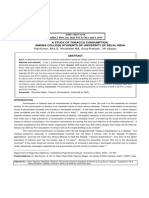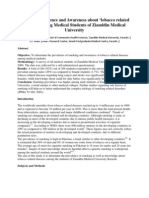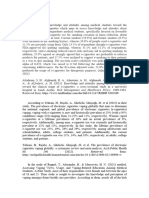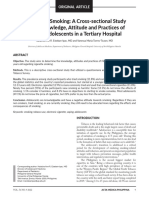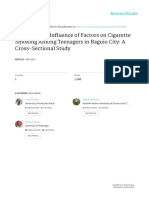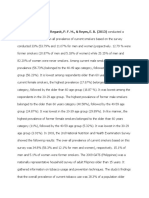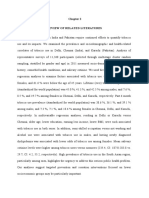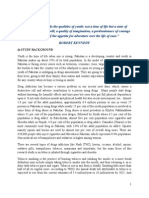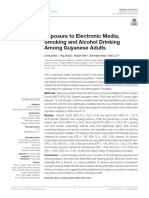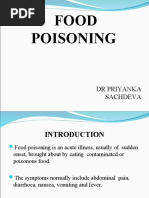Tobacco Use and Oral Health Status Among Adolescents in An Urban Slum, Gurugram
Tobacco Use and Oral Health Status Among Adolescents in An Urban Slum, Gurugram
Uploaded by
priyankaCopyright:
Available Formats
Tobacco Use and Oral Health Status Among Adolescents in An Urban Slum, Gurugram
Tobacco Use and Oral Health Status Among Adolescents in An Urban Slum, Gurugram
Uploaded by
priyankaOriginal Title
Copyright
Available Formats
Share this document
Did you find this document useful?
Is this content inappropriate?
Copyright:
Available Formats
Tobacco Use and Oral Health Status Among Adolescents in An Urban Slum, Gurugram
Tobacco Use and Oral Health Status Among Adolescents in An Urban Slum, Gurugram
Uploaded by
priyankaCopyright:
Available Formats
ISSN: 2456-8090 (online)
ORIGINAL RESEARCH
DOI: 10.26440/IHRJ/02_04/184
QR CODE
Tobacco Use and Oral Health Status among Adolescents
in an Urban Slum, Gurugram
VISHESH YADAV1, SHALINI RAY2, PRIYANKA SACHDEVA3, ANKUR BHAGAT4
INTRODUCTION: Tobacco use is one of the main risk factors for number of chronic diseases including cardiovascular diseases, lung cancer
and oral cancer. Tobacco epidemic is one of the public health threats killing nearly six million people yearly. Tobacco use also contributes to
poor oral health causing staining, bad breath and tooth decay. Different studies in India are suggestive of upward trend in use of tobacco even
A in adolescents.
B OBJECTIVES: To find the prevalence of tobacco use among adolescents in an urban slum and to assess the oral health status among them.
METHODOLOGY: This cross sectional study was done as a part of oral health assessment camp conducted in an urban slum. All adolescents
S attending the camp were recruited in the study after due informed consent, the final sample size being 130.
RESULTS: The overall tobacco use among adolescents was found to be 95.8% adolescent boys and 27.6% among adolescent girls. The most
T common reasons cited for tobacco use were peer pressure followed by parent’s influence. Smokeless tobacco (dry tobacco, lime, guthka) was
R consumed by 39.13% boys and 19% girls. Smoking was prevalent among 16.7% boys and 8.6% girls. However 41.7 % adolescent boys consumed
both forms of tobacco. Prevalence of dental caries was high in both boys (77.7%) and girls (55.2%). The presence of tartar was found in 47.3%
A boys and 22.4% girls. Bleeding gums was found in more no. of girls (29.3%) as compared to boys (25%). The other morbidities found on
C examination were ulcer (16.7% boys and 3.5% girls), Oral submucous fibrosis was seen in 27.8% boys and 3.5% girls.
CONCLUSION: Appropriate intervention is required as adolescence is a tender period where these risk factors like tobacco consumption and
T oral hygiene could be modified by awareness and counselling.
KEYWORDS: Tobacco, Adolescents, Oral Hygiene.
K
INTRODUCTION
Tobacco is the most usually manhandled sedate predominance of tobacco utilization among young
on the planet. Tobacco smoking and chewing are people in urban slum and to assess oral health
the second major causes of death in the world. The status among them.
tobacco loss of life is relied upon to twofold by
2025 from the present 5 million passing (approx). MATERIALS AND METHOD
At each 6.5th second, a man bites the dust on The present cross sectional examination was
account of a tobacco related ailment, all around.1 directed among the young people residing in
The topic for 'World No Tobacco Day-2008'- urban slum Basai which is catered by the urban
Tobacco Free Youth centres around young people health training centre, SGT Medical College,
and required the development of youth gatherings Gurugram. All adolescents (10-19 years) attending
and mindfulness building.2 The most powerless the dental camps organized at urban slum were
time for commencement of tobacco use in India is approached for participation in the study. Those
amid youthfulness and early adulthood i.e., in the adolescents who gave written informed consent
age gathering of 15-24 yr.3 Centring the essential for participation were recruited. In case of
counteractive action among youths is adolescents below 18years, consent was acquired
fundamental. Adolescence is the stage of from the accompanying guardian. A total of 130
transition when they are involved in adolescents were recruited. A predesigned
experimenting with various risk behaviors such as pretested organized poll was utilized for
smoking, risky sexual behavior and tobacco, information accumulation. The information
alcohol and drug use. In the meantime, it might be which was identified with their socio-statistic
less demanding to incorporate solid practices at a qualities and tobacco utilization was gathered
youthful age as opposed to change the conduct at from the adolescents. The socioeconomic status of
later ages or after the beginning of a sickness.4 the investigation subjects was resolved according
Maintaining oral hygiene is shockingly a standout to the modified B.G. Prasad's classification. All
amongst the most disregarded practice among participant were subjected to dental examination
youth particularly in the underprivileged in a well-lit area. The statistical analysis was
provincial and urban ghetto networks. The completed by using percentage and the Chi square
present study was led to discover the test.
International Healthcare Research Journal 2018;2(4):98-102. 98
Tobacco Use and Oral Health Status in Gurugram Yadav Y et al.
RESULTS AND DISCUSSION the prevalence of dental caries was high in both
Table 1 demonstrates the socio demographic boys(77.7%) and girls(55.2%). The presence of
distribution of study participants. About 55.38% tartar was found in 47.3% boys and 22.4% girls.
adolescents were boys and rest 44.6% were girls. Bleeding gums was found in more no. of girls
Around 49.23% adolescents were 14-16years age i.e (29.3%) as compared to boys (25%). The other
mid adolescence. Majority 43% adolescents were morbidities found on examination were ulcer
illiterate. About 75.4% resided in a nuclear family (16.7% boys and 3.5% girls), Oral submucous
and rest 24.6% belonged to joint family. The fibrosis was seen in 27.8% boys and 3.5% girls.
greater part of the adolescents belonged to class Most extreme oral wellbeing and dental issues
III and class IV socioeconomic status. were seen among male as contrast with the female
youths.
Table 2 demonstrates the prevalence of tobacco
utilization among adolescents. In the study area, The relationship between dental caries and
95.8% adolescent boys and 27.6% adolescent girls tobacco utilization was observed to be factually
consumed tobacco. Smokeless tobacco (dry significant (p<0.0001) (Table 5). About 84.2%
tobacco, lime, guthka) was consumed by 39.13% adolescents consuming tobacco had dental caries
boys and 19% girls. Smoking was prevalent among as compared to only 22.8% adolescents who did
16.7% boys and 8.6% girls. However 41.7 % not consume tobacco. One of the principle
adolescent boys expended both forms of tobacco. explanations behind the relationship between
The prevalence of tobacco utilization in teenagers smokeless tobacco and dental caries is the
was 65.3%, which is high. Similar results were nearness of high measure of different sugars and
found in study conducted by Surekha Kishore et sweeteners included amid the business
al5 and Dongare AR et al.6 Sinha DN et al7 detailed assembling of smokeless tobacco items.16
that 75.3% of the understudies who were matured
13 to 15 years in Mizoram were tobacco clients. Fig.1 shows the different reasons cited by
Youthful young men devoured both smokeless adolescents for consuming tobacco. About 52%
and smoke type of tobacco, though the young adolescents initiated tobacco due to peer
ladies expended the smokeless structures as it pressure,14.5% reported influence by relatives,
were. 7.5% adolescents said tobacco consumption
provides social status and 26% opined tobacco
Table 3 demonstrates the relationship between consumption was fashionable. Peer pressure is a
tobacco consumption and gender. The prevalence vital deciding element for commencement of
of tobacco utilization was higher among tobacco use among kids and young people.
adolescent boys (95.8%) as compared to Companion weight is a critical deciding
adolescent girls (27.8%). This difference was component for inception of tobacco use among
observed to be factually significant (p<0.0001). kids and young people.
This finding is practically identical with different
investigations.8,9,10,11 The prevalence found in our CONCLUSION
study was significantly higher than the rates of the The findings in the study suggest that tobacco use
nationwide survey conducted in 2009 which is still an important risk behavior among
reported prevalence of 9.5 percent,12 and a Kerala adolescents. Influence of adolescent is
study in 2011 announcing 9.8 for every penny multifactorial. A portion of these are peer
prevalence.13 Further, the prevalence was much pressure, experimentation amid young, and
lower than discoveries from examines from simple access to such items alongside identity
Western nations which indicated changing factors. At the same time awareness about oral
predominance in the vicinity of 20 and 67 for each hygiene should be encouraged among
penny.14,15 adolescents, Though the significance of oral
cleanliness and tobacco abuse is well-known, the
Table 4 shows the oral wellbeing status of need of awareness programs, visit screening
adolescents. On examination, it was found that camps ought to be underlined by public health
International Healthcare Research Journal 2018;2(4):98-102. 99
Tobacco Use and Oral Health Status in Gurugram Yadav Y et al.
professionals. Youth Tobacco Survey 2006 and 2009. Tob Use
Insights. 2010;3:23–31.
REFERENCES 13.Philip PM, Neetu AP, Binukumar B, Satheesan
1. Abdullah AS, Husten CG. Promotion of smoking B. Evaluation of a tobacco control programme to
cessation in developing countries: a framework for reduce tobacco use among school children in
urgent public health interventions. Thorax 2004; Kerala. Asian Pac J Cancer Prev. 2013;14:3455–9.
59/7:623-30. 14. Johnston LD, O’Malley PM, Miech RA,
2. World No Tobacco Day 2008. Available at: Bachman JG, Schulenberg JE. Monitoring the
http://www.who.int/entiti/ future national results on drug use: 1975-2013:
tobacco/wntd/2008/en/index.html. Accessed 10th Overview, key findings on adolescent drug use.
July 2010. Ann Arbor: Institute for Social Research, The
3. Reddy KS, Gupta PC, editors. Report of tobacco University of Michigan; 2014.
control in India. New Delhi: Ministry of Health 15. Fielding JE. Smoking and women: tragedy of
and Family Welfare, Government of India; 2004. the majority. N Engl J Med. 1987;317:1343–5.
4. Selvan M S, Kurpad A V. Primary prevention: 16. Sajith Vellappally, Zdenek Fiala, Jindra
Why focus on children and young adolescents? Smejkalova, Vimal Jacob, Pilathadka Shriharsha
Indian J Med Res 2004; 120:511-518. Influence of tobacco use in dental caries
5. Kishore S, Garg BS, Muzammil K. Tobacco development, Cent Eur J Public Health 2007; 15 (3):
addiction amongst adolescents in the rural areas 116–21.
of the Wardha district. JK Science 2007; 9/2:79-82.
6. Dongre AR, Deshmukh PR, Murali N, Garg
BS.Tobacco consumption among adolescents in
rural Wardha: Where and how should tobacco
control focus its attention? Indian Journal of
Cancer. 2008; 45/3:100-6.
7. Sinha DN, Gupta PC, Pednekar MS. Tobacco use
among students in the eight north-eastern states
of India. Indian Journal of Cancer 2003; 40/2:43-
59.
8. MOHP/WHO. Nepal 2011 country report GYTS
& GSPS. Kathmandu: MOHP; 2011.
9. Pradhan PMS, Niraula SR, Ghimire A, et al.
Tobacco use and associated factors among
adolescent students in Dharan, Eastern Nepal: a
cross-sectional questionnaire survey. BMJ Open.
2013;3:e002123.doi: 10.1136/bmjopen-2012-002123.
10. Sreeramareddy CT, Kishore P, Paudel J, et al.
Prevalence and correlates of tobacco use amongst
junior collegiate in twin cities of western Nepal: a
cross-sectional, questionnaire-based survey. BMC
Public Health. 2008;8:97. doi: 10.1186/1471-2458-8-
97.
11. Hussain, Abdul Satar Prevalence and
determinants of tobacco use among Iraqi
adolescents: Iraq GYTS 2012. Tob Induc Dis.
2013;11:14. doi: 10.1186/1617-9625-11-14.
12. Gajalakshmi V, Kanimozhi CV. A survey of
24,000 students aged 13-15 years in India: Global
International Healthcare Research Journal 2018;2(4):98-102. 100
Tobacco Use and Oral Health Status in Gurugram Yadav Y et al.
Cite this article as:
Yadav V, Ray S, Sachdeva P, Bhagat A. Tobacco Use and Oral Health Status among
Adolescents In An Urban Slum, Gurugram. Int Healthcare Res J 2018;2(4):98-102. doi:
Source of support: Nil, Conflict of interest: None declared 10.26440/IHRJ/02_04/184.
KAUTHOR AFFILIATIONS:
1. Senior Lecturer, Department of Oral Medicine and Radiology, Eklavya Dental College and Hospital, Kotputli, Rajasthan
2. Assistant Professor, Department of Community Medicine, Faculty of Medical sciences, SGT University, Gurugram, Haryana.
3. PG Resident, Department of Community Medicine, Faculty of Medical sciences, SGT University, Gurugram, Haryana.
4. Senior Lecturer, Department of Oral Medicine and Radiology, Rayat Bahra Dental College and Hospital, Mohali, Punjab.
K
Corresponding Author: For article enquiry/author contact details, e-mail at:
Dr. Vishesh Yadav manuscriptenquiry.ihrj@gmail.com
Senior Lecturer
Department of Oral Medicine and Radiology
Eklavya Dental College and Hospital, Kotputli
Rajasthan
LEGENDS
AGE ADOLESCENT ADOLESCENT GIRLS TOTAL
BOYS(n=72) (n=58) (N=130)
10-13years 26 12 38(29.23%)
14-16years 27 37 64(49.23%)
17-19years 19 9 28(21.54%)
EDUCATION STATUS
illiterate 35 21 56(43%)
Primary 15 17 32(24.6%)
Secondary 17 7 24(18.46%)
High school and above 05 13 18(13.8%)
FAMILY TYPE
Nuclear 61 37 98(75.4%)
Joint 11 21 32(24.6%)
Socioeconomic status
Class I 7 10 17(13%)
Class II 21 14 35(26.9%)
Class III 18 18 36(27.7%)
Class IV 21 6 27(20.7%)
Class V 5 10 15(11.5%)
Table 1. Sociodemographic Profile of Adolescent Participants
International Healthcare Research Journal 2018;2(4):98-102. 101
Tobacco Use and Oral Health Status in Gurugram Yadav Y et al.
Adolescent Boys(n=72) Adolescent Girls(n=58)
Only Smokeless form tobacco 27(39.13%) 11(19%)
Only Smoking Tobacco 12(16.7%) 05(8.6%)
Both forms 30(41.7%) 0
Total 69(95.8%) 16(27.6%)
Table 2. Pattern of Tobacco Consumption among Participants
Adolescent boys(n=72) Adolescent girls(n=58)
Tobacco consumption 69(95.8%) 16(27.58%)
No tobacco consumption 03(4.2%) 42(72.4%)
X2 = 63.13,p<0.0001
Table 3. Association between Tobacco Consumption and Gender
Oral Health status Adolescent Boys(n=72) Adolescent Girls(n=58)
Dental caries 56(77.7%) 32(55.2%)
Tartar 34(47.3%) 13(22.4%)
Plaque 12(16.7%) 03(5.17%)
Bleeding gums 18(25%) 17(29.3%)
Ulcer 12(16.7%) 02(3.5%)
Fibrosis 20(27.8%) 02(3.5%)
Other 14(19.5%) 08(13.8%)
Table 4. Oral Health Status of Adolescents
Dental caries present Dental caries absent
Tobacco consumption 80(84.2%) 15(15.8%)
No tobacco consumption 08(22.8%) 27(77.2%)
X2 = 41.26,p<0.0001
Table 5. Association between tobacco consumption and dental caries
60% 52%
50%
40%
30% 26%
20% 14.50%
7.50%
10%
0%
Peer pressure Influenced by Social status fashionable
relatives
Figure 1. Reasons Cited Among Adolescents for Tobacco Consumption
International Healthcare Research Journal 2018;2(4):98-102. 102
You might also like
- Toxicology For NontoxicologistsDocument225 pagesToxicology For Nontoxicologistsqas100% (3)
- Cholera: Dr. Priyanka SachdevaDocument71 pagesCholera: Dr. Priyanka Sachdevapriyanka100% (1)
- A Study of Tobacco Consumption Among College Students of University of Delhi, IndiaDocument5 pagesA Study of Tobacco Consumption Among College Students of University of Delhi, IndiabaskirathiNo ratings yet
- Method of Research (Final Na Ito)Document86 pagesMethod of Research (Final Na Ito)Jean Madariaga BalanceNo ratings yet
- Smoking Prevalence and Awareness About Lobacco Related Diseases Among Medical Students of Ziauddin Medical UniversityDocument6 pagesSmoking Prevalence and Awareness About Lobacco Related Diseases Among Medical Students of Ziauddin Medical Universityimran82aliNo ratings yet
- Price: Joan CheruiyotDocument10 pagesPrice: Joan CheruiyotAJNo ratings yet
- Tobacco Exposure, Weight Status, and Elevated Blood Pressure in AdolescentsDocument7 pagesTobacco Exposure, Weight Status, and Elevated Blood Pressure in AdolescentsutarinuNo ratings yet
- Elec Cig RRLDocument4 pagesElec Cig RRLAmelite MeriñoNo ratings yet
- Adolescent SmokingDocument9 pagesAdolescent SmokingSarah Ong SiuNo ratings yet
- Cigarette Smoking Teens Published JNSRDocument10 pagesCigarette Smoking Teens Published JNSRTeng Ei LingNo ratings yet
- RRLDocument4 pagesRRLMURILLO, FRANK JOMARI C.No ratings yet
- 03 Oa Prevalence and Causalities ofDocument5 pages03 Oa Prevalence and Causalities ofMG's Fhya Part IINo ratings yet
- A Study On Awareness of Tobacco Use Risk Among High School Children, HyderabadDocument4 pagesA Study On Awareness of Tobacco Use Risk Among High School Children, HyderabadbaskirathiNo ratings yet
- Jrhs 6957Document8 pagesJrhs 6957Adebisi Yusuff AdebayoNo ratings yet
- Letter To The Editor: Prevalence and Correlates of Tobacco Use Among Grade 8-10 Students in Peshawar, PakistanDocument2 pagesLetter To The Editor: Prevalence and Correlates of Tobacco Use Among Grade 8-10 Students in Peshawar, Pakistanm.meena6588No ratings yet
- Factors Affecting Commencement and Cessation of Smoking Behaviour in Malaysian Adults 2012Document7 pagesFactors Affecting Commencement and Cessation of Smoking Behaviour in Malaysian Adults 2012dzoel sasak tvNo ratings yet
- Factors Associated With Cigarettes Use Among High School Students in JakartaDocument7 pagesFactors Associated With Cigarettes Use Among High School Students in JakartaAya Laimeheriwa DahokloryNo ratings yet
- Effects of Health Education On Cigarette Smoking Habits of Young Adults in Tertiary Institutions in A Northern Nigerian StateDocument13 pagesEffects of Health Education On Cigarette Smoking Habits of Young Adults in Tertiary Institutions in A Northern Nigerian StateGaoudam NatarajanNo ratings yet
- 071-005 Factor AssociatedDocument5 pages071-005 Factor AssociatedAzlisonGuilaboBawangNo ratings yet
- 5vape Use Teens GLOBALDocument10 pages5vape Use Teens GLOBALmangahasron.wisdomNo ratings yet
- Chapter 1-5 (Zaman)Document19 pagesChapter 1-5 (Zaman)ALEX OMARNo ratings yet
- Youth in Trouble: Tobacco Use Among School Students in PalestineDocument10 pagesYouth in Trouble: Tobacco Use Among School Students in PalestineCJBAS ManagerNo ratings yet
- RM Intro On GYTSDocument5 pagesRM Intro On GYTSdeepakNo ratings yet
- Research Chapter 1 and 2Document11 pagesResearch Chapter 1 and 2Carl Angelo Martin67% (3)
- Female TobaccoDocument6 pagesFemale Tobaccokunalsom8No ratings yet
- Refusal Self Efficacy Self Esteem Smoking RefusalDocument6 pagesRefusal Self Efficacy Self Esteem Smoking RefusalAishwarya BhapkarNo ratings yet
- Prevalence of Alcohol Consumption and Factors in Uencing Alcohol Use Among The Youth of Tokorni-Hohoe, Volta Region, GhanaDocument11 pagesPrevalence of Alcohol Consumption and Factors in Uencing Alcohol Use Among The Youth of Tokorni-Hohoe, Volta Region, GhanaAathi Raja ThirumaniNo ratings yet
- Smoking Temptation and Susceptibility Among Non-Smokers Adolescents in Chisinau, MoldovaDocument7 pagesSmoking Temptation and Susceptibility Among Non-Smokers Adolescents in Chisinau, MoldovaAculina ZaporojanNo ratings yet
- Document 3 1Document7 pagesDocument 3 1LucyNo ratings yet
- Research Paper 2023 1Document15 pagesResearch Paper 2023 1api-735770422No ratings yet
- Factors Affecting Tobacco Use Among Middle School Students in Saudi ArabiaDocument10 pagesFactors Affecting Tobacco Use Among Middle School Students in Saudi ArabiaChintia Meliana Kathy SiraitNo ratings yet
- ChapterDocument60 pagesChapteralkaisaladja19No ratings yet
- Attitude Among Male Students in 2 Public High School in Zamboanguita 1Document11 pagesAttitude Among Male Students in 2 Public High School in Zamboanguita 1Jeanie TabalNo ratings yet
- Jurnal 1Document6 pagesJurnal 1ChristianWicaksonoNo ratings yet
- SM 280564Document7 pagesSM 280564Luen HoNo ratings yet
- Researchers Reflective Space RRSDocument7 pagesResearchers Reflective Space RRSHEIDE FULLEROSNo ratings yet
- Social Issue .Mahnoor AHmadDocument23 pagesSocial Issue .Mahnoor AHmadMahnoor AhmadNo ratings yet
- Ntac 003Document6 pagesNtac 003ShaileshNo ratings yet
- Cigarette Smoking Teens Published JNSRDocument10 pagesCigarette Smoking Teens Published JNSRJusil RayoNo ratings yet
- Final ResearchsdsDocument24 pagesFinal ResearchsdsVicente AngelesNo ratings yet
- Differences in Adolescents' Smoking Behavior and Media Exposure to Smoking Advertisements in Urban and Rural Padang CityDocument9 pagesDifferences in Adolescents' Smoking Behavior and Media Exposure to Smoking Advertisements in Urban and Rural Padang CityDebri R. FaisalNo ratings yet
- Term Paper in English IV - BDocument18 pagesTerm Paper in English IV - BJai-JaiAdalidNo ratings yet
- RRL KimberlyDocument6 pagesRRL KimberlyjevsprintingNo ratings yet
- Smoking Among Juveniles: A StudyDocument40 pagesSmoking Among Juveniles: A StudySamTimalsina0% (1)
- PMCH: Awareness of The Serious Consequences of Smoking Cigarettes Among Teenagers Studying in UphsdDocument27 pagesPMCH: Awareness of The Serious Consequences of Smoking Cigarettes Among Teenagers Studying in UphsdNakul SrivastavaNo ratings yet
- Cigarette Smoking Teens Published JN SRDocument10 pagesCigarette Smoking Teens Published JN SRLoRenzNo ratings yet
- Examining The Prevalence and Rise Factors of Cigarette Smoking Chap 2Document9 pagesExamining The Prevalence and Rise Factors of Cigarette Smoking Chap 2Gcs GomezNo ratings yet
- Tobacco Inhaling The SmokeDocument17 pagesTobacco Inhaling The SmokeMehreenKhanNo ratings yet
- Annotated Bibliography Trystan Rioux copyDocument8 pagesAnnotated Bibliography Trystan Rioux copytrystan.riouxNo ratings yet
- Influence of Cigarette Warning Label On Smoking Behaviour Among Education Students of Osun State UniversityDocument7 pagesInfluence of Cigarette Warning Label On Smoking Behaviour Among Education Students of Osun State UniversityAlexander DeckerNo ratings yet
- A Qualitative Study On BehaviorDocument5 pagesA Qualitative Study On BehaviorRobby RanidoNo ratings yet
- Cigarette Smoking Teens Published JNSRDocument10 pagesCigarette Smoking Teens Published JNSRAngelo BacalsoNo ratings yet
- Evaluation of Reasons For Excessive Alcohol Use and The Effects On Students of Kampala International University Western CampusDocument13 pagesEvaluation of Reasons For Excessive Alcohol Use and The Effects On Students of Kampala International University Western CampusKIU PUBLICATION AND EXTENSIONNo ratings yet
- Fpubh 10 862975Document10 pagesFpubh 10 862975Hao Nguyen SiNo ratings yet
- SSRN Id3489954Document10 pagesSSRN Id3489954McAdolph MutizeNo ratings yet
- Reasearch Methododlgy CIA: Vipul Pereira 1114340 Iii PsecoDocument7 pagesReasearch Methododlgy CIA: Vipul Pereira 1114340 Iii PsecosnehaoctNo ratings yet
- J. Indian Assoc. Child Adolesc. Ment. Health 2013 9: Review ArticleDocument18 pagesJ. Indian Assoc. Child Adolesc. Ment. Health 2013 9: Review ArticleSUPRATIM BAPULINo ratings yet
- Tobacco Use and Smoke Exposure in ChildrenDocument15 pagesTobacco Use and Smoke Exposure in ChildrenAndreea TanaseNo ratings yet
- Chapter 1 5Document36 pagesChapter 1 5Dino Dizon100% (1)
- Jurnal 8Document8 pagesJurnal 8Rifqiati ArifNo ratings yet
- It Is Possible!: PRINCIPLES OF MENTORING YOUNG & EMERGING ADULTS, #1From EverandIt Is Possible!: PRINCIPLES OF MENTORING YOUNG & EMERGING ADULTS, #1No ratings yet
- Parents' Perceptions of Their Adolescents' Attitudes Towards Substance Use: By Ethnic DifferencesFrom EverandParents' Perceptions of Their Adolescents' Attitudes Towards Substance Use: By Ethnic DifferencesNo ratings yet
- Food Poisoning N AMOEBIASIS - LECTUREDocument60 pagesFood Poisoning N AMOEBIASIS - LECTUREpriyanka100% (1)
- 1 Concepts of HealthDocument8 pages1 Concepts of HealthpriyankaNo ratings yet
- Acute Diarrheal Diseases: Dr. Priyanka SachdevaDocument45 pagesAcute Diarrheal Diseases: Dr. Priyanka SachdevapriyankaNo ratings yet
- AYUSHMAN BHARAT - Lec 7th SemDocument61 pagesAYUSHMAN BHARAT - Lec 7th SempriyankaNo ratings yet
- Phinma NCP Group1 2Document3 pagesPhinma NCP Group1 2Angelica Robles AmaniaNo ratings yet
- Prioritization of Problems Rank Problem Identified: San Francisco St. Butuan City 8600, Region XIII Caraga, PhilippinesDocument5 pagesPrioritization of Problems Rank Problem Identified: San Francisco St. Butuan City 8600, Region XIII Caraga, PhilippinesTom CuencaNo ratings yet
- DENR - Proper Handling of Hazardous WasteDocument16 pagesDENR - Proper Handling of Hazardous WasteNisha HernandezNo ratings yet
- KetamineDocument5 pagesKetamineapi-142637023No ratings yet
- VigoSurge-Supports Coomplete Sexual Issues As Well As Essential Blood Circulation and Cardiovascular Health !Document7 pagesVigoSurge-Supports Coomplete Sexual Issues As Well As Essential Blood Circulation and Cardiovascular Health !vigosurgeNo ratings yet
- DR Ib Mahendra - Work-Shop Hypertensive CrisisDocument54 pagesDR Ib Mahendra - Work-Shop Hypertensive CrisisDesy LestariNo ratings yet
- Consumer Awareness or Disease Mongering - GlaxoSmithKline and The Restless Legs SyndromeDocument5 pagesConsumer Awareness or Disease Mongering - GlaxoSmithKline and The Restless Legs SyndromeonyebuchiannabelNo ratings yet
- Result Entry ReportDocument1 pageResult Entry Reportpoojagasti39No ratings yet
- Jaundice Vs HepatitisDocument4 pagesJaundice Vs HepatitisHomeoDr Babar AminNo ratings yet
- PROQOL5 AmeriCorpsDocument4 pagesPROQOL5 AmeriCorpsMeagen FarrellNo ratings yet
- MRI ScanDocument4 pagesMRI ScanJoel Prabhaker RajNo ratings yet
- Abstract-Firstinhuman Administration of CEB01 A Novel DrugDocument1 pageAbstract-Firstinhuman Administration of CEB01 A Novel DrugIIMSNo ratings yet
- Exercising The Frozen ShoulderDocument4 pagesExercising The Frozen ShoulderMariana MonauniNo ratings yet
- Immunization P & SDocument122 pagesImmunization P & SnebilNo ratings yet
- Community Acquired PneumoniaDocument17 pagesCommunity Acquired PneumoniaDaniel Puentes SánchezNo ratings yet
- Segitiga Penilaian Luka PDFDocument2 pagesSegitiga Penilaian Luka PDFA BNo ratings yet
- Bach Essences For InfluenzaDocument24 pagesBach Essences For InfluenzaJAYAKUMARNo ratings yet
- Weekly-Learning-Plan-Format-Long 10 17 22Document4 pagesWeekly-Learning-Plan-Format-Long 10 17 22Apr CelestialNo ratings yet
- FF Psoriasis SampleDocument11 pagesFF Psoriasis Samplemol3yNo ratings yet
- Assessment of Hand Hygiene of Nursing and Medical Students: Rev Rene April 2017Document12 pagesAssessment of Hand Hygiene of Nursing and Medical Students: Rev Rene April 2017Durga Shankar DhakarNo ratings yet
- (Ebook PDF) Managing Health Services Organizations and Systems, Sixth Edition All Chapters Instant DownloadDocument41 pages(Ebook PDF) Managing Health Services Organizations and Systems, Sixth Edition All Chapters Instant Downloadpecetogurjer100% (3)
- 99 Series - ANSDocument7 pages99 Series - ANSVijay UNo ratings yet
- Health Economics HealthDocument9 pagesHealth Economics HealthAparna Kingini100% (2)
- Developing A Healthy Work Environment and Effective Employee RelationsDocument1 pageDeveloping A Healthy Work Environment and Effective Employee RelationsMary Cherill UmaliNo ratings yet
- Benefit and Contribution ScheduleDocument75 pagesBenefit and Contribution SchedulejonaNo ratings yet
- The Emergency Food Buyer S Guide V10Document0 pagesThe Emergency Food Buyer S Guide V10grelfod100% (2)
- Ra 7277Document41 pagesRa 7277Joanne Ario Billones75% (4)
- Appendicitis PPT 1Document30 pagesAppendicitis PPT 1Prashant Mishra100% (2)
- Vaping in Preganacy A Systematic ReviewDocument8 pagesVaping in Preganacy A Systematic ReviewMia LouwNo ratings yet


